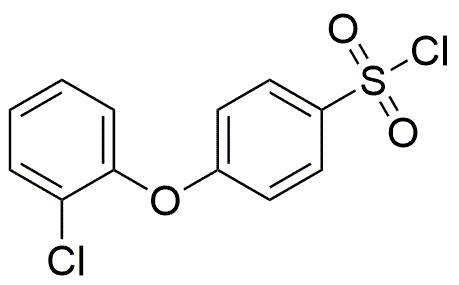4-(2-Chlorophenoxy)benzenesulfonyl chloride is widely utilized in research focused on:
- Synthesis of Pharmaceutical Compounds: This chemical serves as a key intermediate in the production of various pharmaceuticals, particularly in developing anti-inflammatory and analgesic drugs.
- Agrochemical Formulations: It is used in creating herbicides and pesticides, enhancing crop protection by targeting specific plant processes.
- Polymer Chemistry: The compound acts as a coupling agent in polymerization reactions, improving the properties of materials used in coatings and adhesives.
- Diagnostic Reagents: It is employed in the synthesis of diagnostic agents for medical imaging, aiding in the detection of diseases through enhanced imaging techniques.
- Research and Development: This chemical is valuable in academic and industrial research settings for developing new compounds, allowing researchers to explore novel chemical reactions and applications.
General Information
Properties
Safety and Regulations
Applications
4-(2-Chlorophenoxy)benzenesulfonyl chloride is widely utilized in research focused on:
- Synthesis of Pharmaceutical Compounds: This chemical serves as a key intermediate in the production of various pharmaceuticals, particularly in developing anti-inflammatory and analgesic drugs.
- Agrochemical Formulations: It is used in creating herbicides and pesticides, enhancing crop protection by targeting specific plant processes.
- Polymer Chemistry: The compound acts as a coupling agent in polymerization reactions, improving the properties of materials used in coatings and adhesives.
- Diagnostic Reagents: It is employed in the synthesis of diagnostic agents for medical imaging, aiding in the detection of diseases through enhanced imaging techniques.
- Research and Development: This chemical is valuable in academic and industrial research settings for developing new compounds, allowing researchers to explore novel chemical reactions and applications.
Documents
Safety Data Sheets (SDS)
The SDS provides comprehensive safety information on handling, storage, and disposal of the product.
Product Specification (PS)
The PS provides a comprehensive breakdown of the product’s properties, including chemical composition, physical state, purity, and storage requirements. It also details acceptable quality ranges and the product's intended applications.
Certificates of Analysis (COA)
Search for Certificates of Analysis (COA) by entering the products Lot Number. Lot and Batch Numbers can be found on a product’s label following the words ‘Lot’ or ‘Batch’.
*Catalog Number
*Lot Number
Certificates Of Origin (COO)
This COO confirms the country where the product was manufactured, and also details the materials and components used in it and whether it is derived from natural, synthetic, or other specific sources. This certificate may be required for customs, trade, and regulatory compliance.
*Catalog Number
*Lot Number
Safety Data Sheets (SDS)
The SDS provides comprehensive safety information on handling, storage, and disposal of the product.
DownloadProduct Specification (PS)
The PS provides a comprehensive breakdown of the product’s properties, including chemical composition, physical state, purity, and storage requirements. It also details acceptable quality ranges and the product's intended applications.
DownloadCertificates of Analysis (COA)
Search for Certificates of Analysis (COA) by entering the products Lot Number. Lot and Batch Numbers can be found on a product’s label following the words ‘Lot’ or ‘Batch’.
*Catalog Number
*Lot Number
Certificates Of Origin (COO)
This COO confirms the country where the product was manufactured, and also details the materials and components used in it and whether it is derived from natural, synthetic, or other specific sources. This certificate may be required for customs, trade, and regulatory compliance.


